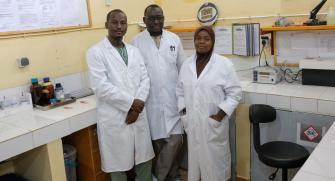Improving diagnosis of tuberculosis in severely malnourished children.
Tuberculosis (TB) is a serious comorbidity for children with severe acute malnutrition and malnutrition increases the risk of TB mortality. At the same time, TB diagnosis in children is particularly challenging and we lack simple diagnostic tools for better integration of TB diagnosis in pediatric malnutrition wards.
LAM test: a point-of-care test in urine
Since 2013, we have a point-of-care assay available that detects the LAM-antigen of TB in urine specimens. Urine specimens are easy to collect, and the LAM test provided results within 20 minutes at point-of-care. Still very little evidence exists for LAM-testing in pediatric populations. As of today, the urine LAM- test is only recommended in HIV-positive children with symptoms of TB or severely immuno-compromised.
“We hypothesized that the Determine™ LAM-test may also have a diagnostic value in (mainly HIV-negative) children with severe acute malnutrition, considering that immune dysfunction can also be found in association with malnutrition” explains Birgit Schramm, epidemiologist at Epicentre and first author of this study.
The exploratory study was conducted among children under 5 years of age hospitalized with severe acute malnutrition in the MSF-supported malnutrition treatment center in Madaoua, Niger, where HIV-prevalence is low and TB incidence is high.
Study findings
“Our findings are encouraging and suggest a potential value of LAM urine testing in HIV-negative children with severe acute malnutrition” says the epidemiologist.
The LAM test may identify a proportion of severely malnourished children with TB (one of five) who could then benefit from rapid treatment initiation. The study was conducted in an operational setting where TB diagnosis was mainly based on clinical signs or symptoms. Further studies on the performance of the TB LAM test in this specific pediatric population are warranted, including comprehensive performance evaluation with a systematic microbiological reference standard and using new generation LAM tests that are now becoming available.










